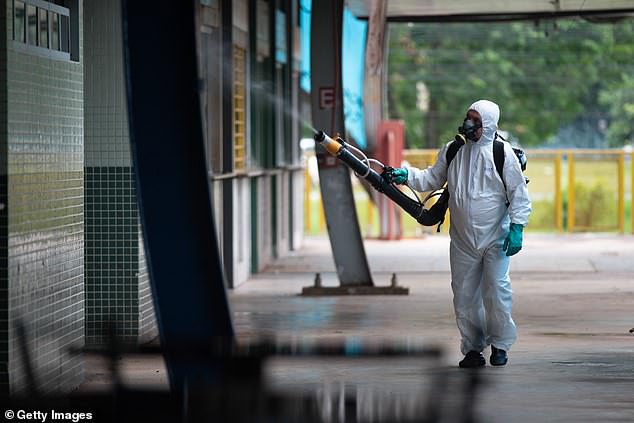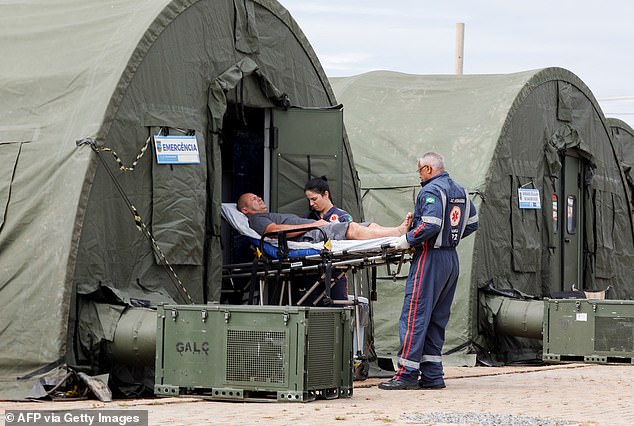How Brazil’s ferocious dengue fever outbreak is a warning to the world: Patients motionless on waiting room floors, wailing in agony from ‘bone breaking disease’
Dengue fever is spreading wildly across much of South America, forcing patients to languish on hospital floors while doctors become overwhelmed.
Brazil has recorded more than 1.5 million cases and 390 deaths from the disease this year alone, fast approaching a total of 1.6 million confirmed cases in all of 2023.
And other countries on the continent, including Peru, Paraguay and Argentina, are struggling to keep up with widespread outbreaks.
Doctors and patients in the capital Brasilia say scenes similar to Covid’s darkest days are emerging. Patients with the disease, dubbed ‘bone-breaking disease’ because of the incredible pain it causes to joints and bones, can be heard as overwhelmed doctors struggle to meet demand.
Epidemiologists blame global temperature rise for allowing the mosquito that carries the virus to live longer and thrive over a wider area.
Hospitals have been overwhelmed, forcing patients to wait on the floor or in wheelchairs for care

Brazilian officials have started fumigating the streets of major cities in the hunt for the mosquitoes that transmit dengue
It has prompted state health officials to sweep through 17 cities that have declared states of emergency, fumigating properties and advising people on the best way to prevent infection.
The CDC has warned about the rising number of cases.
Gabriela Paz-Bailey, a dengue specialist at the CDC, said: “The number of dengue cases is rising at an alarming rate.
“It’s going to be a public health crisis and it’s going to be in places where it’s never happened before.”
There is a risk that what is happening in South America could also happen in the US, much of the south, and much of Europe as temperatures continue to rise.
Florida reported a record 178 cases of local transmission last year. Hawaii, Texas, Arizona and California have also reported community spread.
Albert Ko, an epidemiologist at Yale University, said: ‘There has not been extensive transmission in the US, but that could change.
“We should be concerned that a major epidemic season in Brazil and the rest of South America will fuel spread and transmission to places in the US.”
Meanwhile, hospital beds are running out across Brazil.
Loide Rocha dos Santos, 57, went to a crowded hospital last month and immediately felt the chaos.
Dengue had reduced her platelet count to a dangerous low, yet the health clinic in the Gama region could do little to accommodate her, according to the WashingtonPost.
She said: ‘The first two days I had to sit in a wheelchair. They didn’t have a bed for me.’

Field hospitals in strategic locations around Brazilian cities are struggling to keep up with the number of people needing care
Dengue, nicknamed the “bone-breaking disease” because it causes joint and muscle pain so severe it feels like the bones are breaking, is a virus that typically runs its course and goes away. But in as many as one in twenty cases this can lead to bleeding and organ failure.
It usually causes a range of flu-like symptoms, such as fever, headache, aches, nausea, swelling and rash, for one to two weeks, but it can develop into a serious and fatal infection.
While cases and deaths are skyrocketing in Brazil, Peru is experiencing a similarly large outbreak, with 32 deaths and 31,000 infections in the first two months of 2024 alone. increase of 97 percent in the same period last year.
The situation has become so dire that tent hospitals have even been built at strategic points in Brasilia and other cities to assess patients with the virus.
Paraguay and Argentina have recorded more than five times the typical number of cases so far this year more than 150,000 and 57,000 casesrespectively.
The outbreaks in South America, which is currently experiencing the end of the summer season, could be a harbinger of what could happen in the Northern Hemisphere.
Rising temperatures and the El Nino phenomenon that brings intense rain have turned some countries into an oven where mosquitoes can thrive.
Thais dos Santos, regional advisor on mosquito-borne viruses at the Pan American Health Organization, said: “Arboviral diseases are these mosquito-borne viruses that are a really excellent sentinel for the impacts of climate change and human health.”
The Aedes aegypti thrive in tropical, subtropical and temperate climates. Higher temperatures during longer warm seasons allow mosquitoes to live longer, even within a few days, increasing the number of cases.
Ms dos Santos added: ‘The warmer temperatures certainly provide conditions for better transmission of these viruses.
‘What we are seeing are longer transmission periods. We’re seeing the virus being transmitted in areas we haven’t seen before.”
